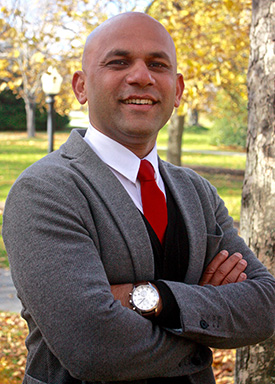In the global hunt for both a cure and cancer treatments, researchers are finding it may be the very viruses we try to shield ourselves against that hold great promise in fighting the deadly disease.
Pathogens — those bugs that routinely infect and sicken us, like the common cold or influenza — are being studied in labs around the world to see if they can be used safely and effectively to attack and kill cancer cells. It is not a new theory, but one that has been showing such success that it is being explored for a range of viruses and forms of cancer.
 "We know we can engineer almost any virus to do this because as long as a virus is safe and not causing any disease, we can engineer them to be used as cancer therapies," says Dr. Shashi Gujar (shown right), a cancer researcher and professor at Dalhousie who specializes in immunotherapy.
"We know we can engineer almost any virus to do this because as long as a virus is safe and not causing any disease, we can engineer them to be used as cancer therapies," says Dr. Shashi Gujar (shown right), a cancer researcher and professor at Dalhousie who specializes in immunotherapy.
"This is an amazing technology and has so much potential. However, we need to make sure that this technology gets developed with stringent standards at the global stage. This will ensure that this amazing anti-cancer drug is developed in a proper manner and reaches cancer patients faster."
To that end, Dr. Gujar and colleagues around the world who are driving the exploration of this emerging technology decided it was important to have a guidebook with standards on the development and usage of viruses to fight cancer, known as oncolytic viruses (OVs). Technically speaking, that is onco=tumour and lysis=breaking down.
Dr. Gujar, along with pioneers Dr. Guido Kroemer of the Centre de Recherche des Cordeliers in Paris and Dr. John Bell of the University of Ottawa, have just released a paper in the journal, Nature Protocols, that provides standardized guidance on oncolytic virus design, production and testing in cancer immunotherapy, which is a type of cancer treatment that helps the body's immune system fight cancer.
Turning enemies into allies
The paper describes OVs as a novel class of cancer immunotherapy agents that infect and destroy cancer cells, while also providing a secondary benefit of promoting protective antitumor immunity.
But how does that work?
"Our immune system is designed to recognize threats in a very specific manner. When we are infected with a virus or bacteria, our immune system can immediately recognize them as 'foreign' and mount an effective immune response to eliminate them" says Dr. Gujar.
Cancers, being 'non-foreign' however, can fool the body because they have similar characteristics as healthy cells. That makes the immune system think there is nothing it needs to do, allowing the cancer to 'hide' and spread.
So, decades ago scientists began asking whether viruses, which are eliminated by effective immune response, could be used to target cancer cells. They had seen that some cancer patients who developed infections actually reported that their cancer cells had decreased or disappeared.
More recently, studies have suggested that cancer patients who developed COVID-19 saw their cancer regress following recovery from their COVID infection.
"That's what these viruses do — they get the attention from your immune system and get them to attack the cancers," Dr. Gujar says.
"It's almost the equivalent of indirect vaccination of a person. For example, if you want to train your immune system for COVID, you give a COVID vaccine. Here, if you want to train your immune system to attack cancer, you use an oncolytic virus because it will train your immune system to recognize cancer as a threat."
From testing to therapy
Before oncolytic viruses can be used in therapy, they need to be tested to make sure that they don't cause illness and only target cancer cells.
The United States, China, Europe and Japan have so far approved OV technology, which has been used successfully in the treatment of several cancers, such as melanoma. Viruses being considered or approved for cancer therapy include herpes simplex, reovirus, measles and adenovirus.
Canada has not yet approved its use, but is at the forefront of OV research and has some of the world's largest labs focused on its development.
Dr. John Bell, a co-author and one of the first generation of scientists working on OVs in Canada, says the paper is aimed at ensuring people entering the field are following the best practices so new knowledge meets international standards. It covers everything from which viruses should be used and what their characteristics are to the process of getting to the stage where they are ready to apply for clinical trials.
"Exciting new clinical data from a number of oncolytic viruses is building excitement in the field," says Dr. Bell. "It is critical that rigorous standards are set to allow comparison of the safety and efficacy of these innovative virus products."

